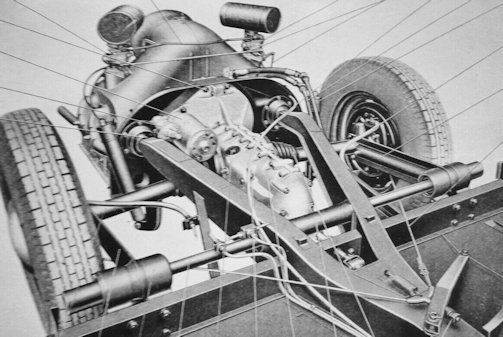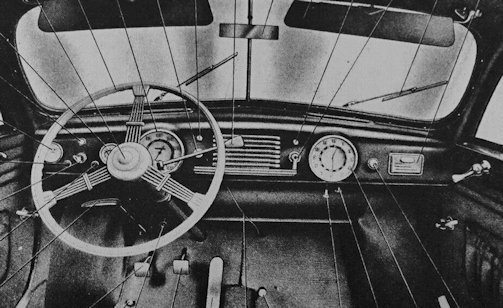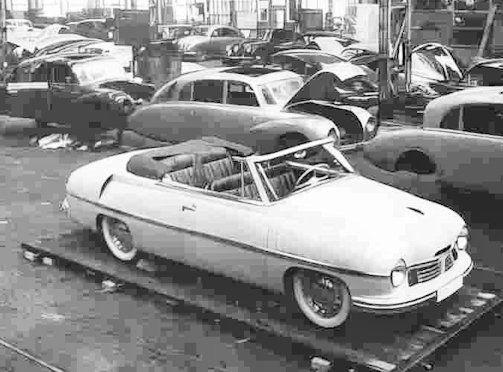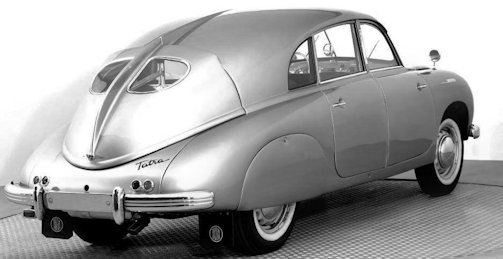Tatra Tatraplan Typ 600
 |
|
|
Production period: |
1948 to 1952 |
|
Class: |
Motor Car |
|
Body versions: |
Saloon |
|
Engines: |
Gasoline :2.0 litres |
|
Length: |
4540 mm |
|
Width: |
1670 mm |
|
Height: |
1520 mm |
|
Wheelbase: |
8ft 10in (270 cm) |
|
Curb weight: |
1200 kg |
The Tatra 600 or Tatraplan is a car model with aerodynamically shaped body of the former Czechoslovak and today Czech vehicle manufacturer Tatra.
History
The Tatraplan is somewhat unusual in appearance. The body (which is built integrally with the chassis) is very streamlined and has a fin at the back which passes between the rear windows. There is evidence of the rear-engine in the two air intakes at the side back windows and the apparent thickness of the bodywork the back of the car and the back seats.
in 1923 the first Tatra with an air-cooled engine was introduced, followed in 1934 by their first rear-engine model. the Tatraplan, which has a " flat-four " four-stroke air-cooled engine in the rear. This has a bore of 85 mm. and a stroke of 86 mm. giving a capacity of 1,950 c.c. and at 4,000 r.p.m., 52 b.h.p. is developed. O.h.v. design is used, and there are two carburettors,
one for each pair of cylinders. There is a large fan mounted above the crank-shaft and a large cowling encloses both this and the cylinder block to ensure adequate circulation of air. Suspension front and rear is independent: there are two transverse leaf-springs at the front mounted one above the other, while torsion bars are used in conjunction with swinging axles at the rear. Telescopic shock absorbers and hydraulic brakes are incorporated. The four-speed gear-box is controlled from the steering column.

The front grille is simple and the top of the " bonnet " which houses the spare wheels and luggage is curved. The " six-light "four-door body seats six. The windscreen is V-shaped and the
facia board, although simple in layout, has a loudspeaker grille and a large clock, apart from the usual instruments. It is perhaps interesting to note that when the driver looks through his two back windows, he or she is looking through three panes of glass. This is because there is a double window in the bulkhead between the engine and the interior (to minimise noise from the engine) and a further thickness of glass in the engine cover. To avoid obstructing the view, the air filters are placed just out of the line of vision.
This was the first after 1945 newly constructed Tatra car and as such the successor of the Tatra 97 and only a short time-built Tatra 107. The production ran from 1948 to 1952. Last year she was transferred to AZNP (Škoda) to Mladá Boleslav to Tatras capacities for the truck Construction. The car was increasingly exported over time and found a number of customers in Europe and overseas. A total of 6342 copies were produced by the Tatra Plan.
Immediately after the end of the Second World War ran in May 1945 at Tatra in Kopřivnice (Nesselsdorf) production again. The work was hardly affected by war damage. Initially, the production of passenger car and truck models from the prewar period continued. In 1946, the 107 built just a year as a modified version of the previous model 97 with a new 1750 cc OHV engine, new suspension with independent suspension and central box frame with partially self-supporting body appeared.
In 1938, after the incorporation of the Sudetenland into the German Reich, the Type 97 had been set on Hitler's orders because of its similarity to the KdF car. Now the development of a completely new middle - class car of the same design with air - cooled four - cylinder rear engine began. The new and significantly more modern designed car, which developed the experience with the T107, should bear the name Tatra T600 with the epithet Tatraplan. The name Tatraplan is a wordplay with double meaning, because on the one hand the introduction of the state-controlled planned economy in Czechoslovakia should be symbolized, on the other hand one wanted to allure the good aerodynamic qualities of the body similar to that of an airplane advertising effective (compare e.g., with the English Word "Airplane", Czech), which emerges from contemporary sales brochures and billboards. The project was headed by Tatra's newly appointed Julius Mackerle after long-time chief engineer Hans Ledwinka was deposed and detained.

The first prototype, "Ambrož”, was built in December 1946 by hand, the second prototype "Josef" in March 1947. The Tatraplan received a newly designed larger air-cooled four-cylinder -Viertakt- Otto -Boxer motor in the rear with OHV - valve control (an underlying Camshaft, bumpers and rocker arm), a displacement of 1952 cc and a power of 52 hp (38 kW) at 4000 / min. That with a stroke ratio of 85 × 86 almost square designed aggregate had with 26 HP per Liter displacement the same specific achievement as the engine of the larger Tatra 87 (V - eight-cylinder, 2958 cm³, 75 HP, 160 km / h). The chassis had an independent front suspension on two transverse leaf springs on top of each other and in the rear the Tatra already traditional swing axle, in this case with torsion bar suspension. The car reached a top speed in excess of 130 km / h, with the optional longer version available for the predominant use on the shallower land, just over 140 km / h. In the for his Class unusually spacious interior of the self-supporting all-steel body found place on two benches six people. The drag coefficient was measured at 0.32.

- Power: 52 hp (38 kW) at 4000 rpm
- Maximum speed: 130 km / h (factory specification), with optional longer transmission 140 km / h
- Consumption: 11 litres / 100 km
The new model introduced by the TATRA factory is the result of tests and trial work extending over several years. It meets the most exacting demands respect Of
Speed and cfriving comfort,The shape of the body has received especially extensive trials. Each separate profile of the model wc's designed and tested in accordance; with the latest aerodynamictheory. Final overall shape of the car emerged as a result, of extensive wind tunnel experiments, A great number of models and studies with extensive and thoroughh work devoted to this task to attain a shape most suitable to the aerodynamic theories and guaranteeing the minimum air resistance. The proper technical work has been advantageously supplemented by the proposals of the designers with whose help the present model gained in appearance and elegance. Similarly interior has been created with artist-designers so that its arrangement is spaciousness for even the most pretentious motorist, The interior offers comfortable accommodation for 2 to 3 people in the front and for 3 in the rear seats. The dashboard may be fitted with a
radio. The all-metal four-door body is self-supporting and is welded in one piece with the central backbone. In winter it is heated by hot air passing through heating elements.
A spacious luggage trunk Of 10 Cub.ft- Capacity (for about 220 1b of baggage) provided.

After extensive testing, the series production of the Tatra Plan began in 1948; Tatra was the same year after the February overthrow of the communists nationalized. Around the same time, export and use of the car in motorsport began. The Tatraplan found quite a good sales success and measured by the rather bad economic situation of most countries in the after 1945 also in the export numerous buyers. Interestingly, in addition to orders from other states in the Eastern Bloc, including the Soviet Union, 168 were from Canada and 200 from the People's Republic of China one. Most of the cars, namely 435, were exported to Austria, 1953 went to West Germany and 153 to Switzerland. The total of 184 cars for Sweden were built because of the left-hand traffic with left-hand drive, which was still used there until 1967. The Tatraplan was so because of its success abroad to one of the " currency procurers " of the government of Czechoslovakia from 1948, but also proved inland as surprisingly successful, especially since he in contrast to the still produced until 1950 larger Tatra 87 with V8 engine in similar Space was a lot cheaper.
In addition to the standard sedan with four doors and six seats emerged in small numbers, a version as an ambulance with combi -like structure and a pickup truck with rear cargo area from the B-pillar. These two variants had, unlike the sedan, a front engine, which was installed 180 degrees rotated about the vertical axis.
As sporty versions there were z. B. the two-door Tatra 601 Tatraplan Monte Carlo and the Tatra 602 Tatraplan Sport. They drove from 1948 to 1953 - one year after the end of production - racing successes. Some specimens were equipped with the 2545 cc V8 engine of the later new model Tatra 603, with which the Tatraplan Sport - without further performance increase - could reach over 170 km / h.
A special feature was the Tatra 601 Tatraplan Cabriolet, a single open vehicle based on the two-door sports model Tatra 601, which was built in 1951 with a slightly different front by the famous body company Sodomka and was given to the Soviet state and party leader Josef Stalin.
In the same year 1951 the state planning department of the ČSR decided to move the production of the Tatraplan to AZNP (Škoda) to Mladá Boleslav. Tatra should be completely switched to truck production following the discontinuation of the last passenger car model, as planned by the RGW. This decision was extremely unpopular with the workforces of both companies, and since production at Škoda was rather bad, it was decided that, despite the success in the market the car had (and still could have), after just one year in Mladá Boleslav 1952, which caused regret, especially on the export markets. The Tatra plan was the last mid-range car of Tatra and found after the end of production even later no successor. A total of 6342 specimens were built, of which 4242 in Kopřivnice and 2100 in Mladá Boleslav.
The cars built at Škoda can be easily distinguished by the rounded rather than pointed top of the rear hood and a few other small details, but are otherwise the same. Overall, Škoda had difficulty meeting the quality standard of Tatra.
In the last year of production in 1952, three prototypes of the Tatra 600 Diesel, also known as Tatraplan Diesel, were built. The vehicle had the chassis and body of the production vehicle with petrol engine, but an air-cooled 4-cylinder diesel boxer engine also with 1952 cc displacement and a power of 42 hp (30.8 kW) at 3300 / min. He accelerated the car to 100-110 km / h with a consumption of 8 to 9 ltr. /100 km. The start of series production was planned; Economic difficulties prevented this.

Prototypes
- Tatra 600 "Ambrož" (1946)
- Tatra 600 "Josef" (1947)
- Tatra 600 Tatraplan Sport (1950),
- Tatra 600 Diesel (1952)
Special versions
- Tatra 600 Tatra Plan
- Tatra 600 Tatraplan ambulance (with front engine)
- Tatra 600 Tatraplan pickup truck (with front engine)
- Tatra 601 Tatraplan Cabriolet (single piece as a gift for Josef Stalin)
- Race versions
- Tatra 601 Tatraplan Monte Carlo (including single copies with the V8 engine of the later type 603)
- Tatra 602 Tatraplan Sport

Technical
-
Tatra 600 Tatraplan Technical details and specifications (1948-1952)
DIMENSIONS AND WEIGHT:
Wheelbase, 8ft 10in (270 cm)
Length: 4540 mm
Width: 1670 mm
Height: 1520
Front gauge: 1300 mm
Rear gauge: 1300 mm
Ground clearance: 225 mm
Weight (approx.), 2,552 1b (1,160 kg).
Tank capacity, 10 Imperial gallons (56 litres).
Tyre size, 6.00—16in.
Turning circle, 44ft (1,350 cm)ENGINE:
four cylinder
four cycle
boxer engine with OHV valve control
air-cooled (1 axial cooling fan)
2 downdraft carburettors Solex 32 UBIP
Bore × stroke: 85 × 86 mm
Displacement: 1,950 c.c. (118.9 cu. in)
Compaction: 6: 1TRANSMISSION DRIVE LINE:
Clutch: Single-disc dry clutch
four-speed manual gearbox (4 + R) with overdrive,
ratios (3.93), 5.89, 9.24 and 14.52 to 1
middle shift, 2nd / 3rd / 4th Gear synchronized
Drive type: rear-wheel driveSUSPENSION:
Front axle: Independent wheel suspension on 2 overlapping transverse leaf springs
Rear axle: swing axle , torsion bar suspensionBRAKES:
Hydraulic four-wheel drum brakes
handbrake mechanically acting on rear wheelsProduction
country
quantity
Albania
20
Egypt
45
Belgium
167
BR Germany
195
China (VR)
200
GDR
46
Yugoslavia
76
Canada
168
Morocco
29
Netherlands
60
Austria
435
Poland
97
Romania
17
Hungary
146
Sweden
184
Switzerland
153
Soviet Union
126
total
2164
© Motor car History
